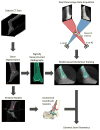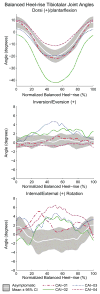Application of High-Speed Dual Fluoroscopy to Study In Vivo Tibiotalar and Subtalar Kinematics in Patients With Chronic Ankle Instability and Asymptomatic Control Subjects During Dynamic Activities
- PMID: 28800713
- PMCID: PMC5914166
- DOI: 10.1177/1071100717723128
Application of High-Speed Dual Fluoroscopy to Study In Vivo Tibiotalar and Subtalar Kinematics in Patients With Chronic Ankle Instability and Asymptomatic Control Subjects During Dynamic Activities
Abstract
Background: Abnormal angular and translational (ie, kinematic) motion at the tibiotalar and subtalar joints is believed to cause osteoarthritis in patients with chronic ankle instability (CAI).
Methods: In this preliminary study the investigators quantified and compared in vivo tibiotalar and subtalar kinematics in 4 patients with CAI (3 women) and 10 control subjects (5 men) using dual fluoroscopy during a balanced, single-leg heel-rise and treadmill walking at 0.5 and 1.0 m/s.
Results: During balanced heel-rise, 69%, 54%, and 66% of mean CAI tibiotalar internal rotation/external rotation (IR/ER), subtalar inversion/eversion, and subtalar IR/ER angles, respectively, were outside the 95% confidence intervals of control subjects. During 0.5-m/s gait, 50% and 60% of mean CAI tibiotalar dorsi/plantarflexion and subtalar IR/ER angles, respectively, were outside the 95% confidence intervals of control subjects. During 1.0-m/s gait, 62%, 65%, and 73% of mean CAI subtalar dorsi/plantarflexion, inversion/eversion, and IR/ER, respectively, were outside the 95% confidence intervals of control subjects. Patients with CAI exhibited less tibiotalar and subtalar translational motion during gait; no clear differences in translations were noted during balanced heel-rise.
Conclusion: Overall, the balanced heel-rise activity exposed more tibiotalar and subtalar kinematic variation between patients with CAI and control subjects. Therefore, weight-bearing activities involving large range of motion, balance, and stability may be best for studying kinematic adaptations in patients with CAI.
Clinical relevance: These preliminary results suggest that patients with CAI require more tibiotalar external rotation, subtalar eversion, and subtalar external rotation during weight-bearing stability exercises, all with less overall joint translation.
Keywords: chronic ankle instability; dual fluoroscopy; heel-rise; tibiotalar and subtalar kinematics; treadmill gait.
Figures







References
-
- Bassett FH, 3rd, Gates HS, 3rd, Billys JB, Morris HB, Nikolaou PK. Talar impingement by the anteroinferior tibiofibular ligament. A cause of chronic pain in the ankle after inversion sprain. J Bone Joint Surg Am. 1990;72(1):55–59. - PubMed
-
- Brodsky AR, O’malley MJ, Bohne WH, Deland JA, Kennedy JG. An analysis of outcome measures following the Brostrom-Gould procedure for chronic lateral ankle instability. Foot Ankle Int. 2005;26(10):816–819. - PubMed
Publication types
MeSH terms
Grants and funding
LinkOut - more resources
Full Text Sources
Other Literature Sources

